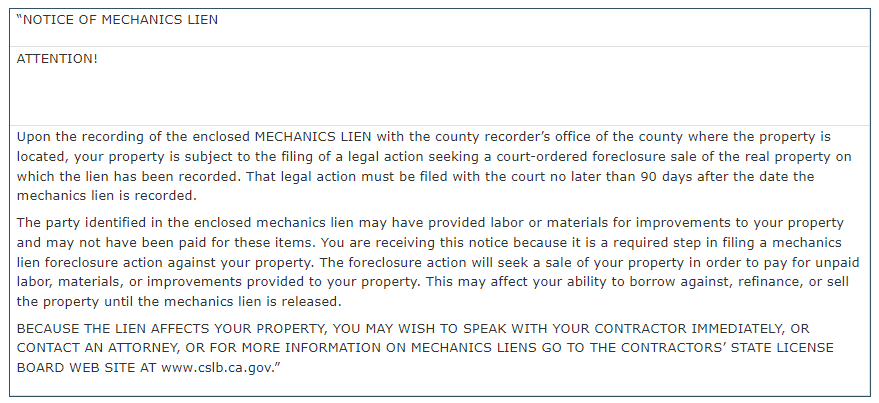What Information Should be Included in Your California Mechanic’s Lien?
We serve preliminary notices, file mechanic’s liens, and serve bond claims ALL DAY EVERY DAY for clients throughout the country. And, as I take a bite of humble pie, might I add we are truly awesome at it? Although we are the best in the biz, there are many suppliers, subcontractors, and general contractors who prefer to handle the documentation on their own. So, today’s post is for all you DIY-ers. Here’s a breakdown of the information you should include within your California mechanic’s lien.
[NOTE: this information is provided simply for educational purposes and is no way legal advice. We always recommend seeking professional, legal guidance.]
Ah, California Mechanic’s Liens and the California Civil Code
If that title doesn’t grab you and suck you right into the story, I have no idea what will! Let’s get to it.
According to 8416 of the California Civil Code, the mechanic’s lien should include the following information:
ARTICLE 2. Conditions to Enforcing a Lien [8410 – 8424]
8416.(a) A claim of mechanics lien shall be a written statement, signed and verified by the claimant, containing all of the following:
(1) A statement of the claimant’s demand after deducting all just credits and offsets.
(2) The name of the owner or reputed owner, if known.
(3) A general statement of the kind of work furnished by the claimant.
(4) The name of the person by whom the claimant was employed or to whom the claimant furnished work.
(5) A description of the site sufficient for identification.
(6) The claimant’s address.
(7) A proof of service affidavit completed and signed by the person serving a copy of the claim of mechanics lien pursuant to subdivision (c). The affidavit shall show the date, place, and manner of service, and facts showing that the service was made in accordance with this section. The affidavit shall show the name and address of the owner or reputed owner upon whom the copy of the claim of mechanics lien was served pursuant to paragraphs (1) or (2) of subdivision (c), and the title or capacity in which the person or entity was served.
(8) The following statement, printed in at least 10-point boldface type. The letters of the last sentence shall be printed in uppercase type, excepting the Internet Web site address of the Contractors’ State License Board, which shall be printed in lowercase type:

Clear as Mud, Right?
I know, it’s a lot of statutory language, maybe this will help translate.
(1) A statement of the claimant’s demand after deducting all just credits and offsets.
This would be your claim amount or the amount you’re owed.
(2) The name of the owner or reputed owner, if known.
The owner of the property and/or project. You should be able to identify this information through proper title work.
(3) A general statement of the kind of work furnished by the claimant.
A description of the labor or materials you provided to the project. It should be specific enough that parties involved could identify your contribution. It doesn’t have to be a lengthy description.
(4) The name of the person by whom the claimant was employed or to whom the claimant furnished work.
This would be your customer’s information.
(5) A description of the site sufficient for identification.
This is the project address or the parcel ID number (aka APN).
(6) The claimant’s address.
If you are filing the lien, you are the claimant, so you will list your address.
(7) A proof of service affidavit completed and signed by the person serving a copy of the claim of mechanics lien pursuant to subdivision (c). The affidavit shall show the date, place, and manner of service, and facts showing that the service was made in accordance with this section. The affidavit shall show the name and address of the owner or reputed owner upon whom the copy of the claim of mechanics lien was served pursuant to paragraphs (1) or (2) of subdivision (c), and the title or capacity in which the person or entity was served.
This is proof you served the mechanic’s lien upon the correct parties and that it was served timely.
(8) The following statement, printed in at least 10-point boldface type. The letters of the last sentence shall be printed in uppercase type, excepting the Internet Web site address of the Contractors’ State License Board, which shall be printed in lowercase type
This is important. Many states have requirements as to font size and specific language that must appear within the lien. There are instances where lien claimants have lost their lien rights because they failed to comply with the statutory language. Make sure you follow the statute’s instructions carefully.

Reminder About California Mechanic’s Lien Rights
Generally, to protect your mechanic’s lien rights on private California projects, you should serve your preliminary notice within 20 days from your first furnishing. You can serve a late notice, but the lien will only be effective for your furnishings provided 20 days prior to the service of the notice and any furnishing thereafter.
In the event you are unpaid, subcontractors and material suppliers should file your mechanic’s lien after you’ve completed furnishing but within 30 days from the recording of the Notice of Completion or 90 days from completion if the Notice of Completion isn’t recorded. (Remember, Completion is entire project completion – completion of the General Contract – not just completion of your furnishing.) Conservatively, and for the sake of your cash flow, you may want to file your lien sooner rather than later – Completion could be a long way off and you don’t want to wait months, or worse, years, for your money.
If the lien does not prompt payment, you should file suit to enforce your lien within 90 days from filing the lien.
Um, Maybe I Shouldn’t Do This on My Own
If you can handle it on your own, by all means, please do. But, if you have even the slightest hesitation, I recommend using NCS. Mechanic’s liens can be fickle creatures and you certainly don’t want to lose your right to recover payment because of avoidable mistakes. We’re here and ready to help!
